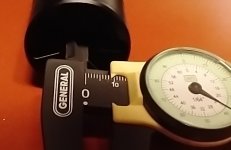Ok, ... It is a matter of degree because you don't have an exact measurement either. By your argument your measurements are meaningless as well. They are just "less" meaningless, right? In a world where .4mm is a small measurement, the tolerances you are describing are very difficult to achieve..
and may not even be necessary. You might be able to thread a needle at a thousand yards but you are going to spend a lot of time setting that up which you could spend more productively. Really? noise is what they hear. It is up to you to decide what they are "measuring".
Yea, that part is
your job. It is your job as the engineer to understand these "pesky" details and measure the right things.
No sir, it may be only "personal perception" at the end of YOUR day. At the end of my day it is about what I can measure. It seems that almost every person who builds moderators says, "Don't trust your meter. Trust your ears." That's convenient, don't you think? It is fine in a world where one fellows "great" is six decibels louder than the next fellow's "crappy". Builders say, "you can't trust the measurements you make." because that is what they WANT you to believe.
It is an excuse for not understanding WTF they ARE measuring or how to measure it for that matter. Good for you.
I can measure them. I don't even bother with minuscule clearances like the ones you are describing. If I can't build to those tolerances then why should I bother? I had better find another way, or give up. I have observed that anything tighter than about 0.5mm
windage doesn't seem to make a whole lot of difference. That may be because I have trouble measuring it. That might be due to the viscosity of HPA itself. I have not really spent a lot of time thinking about it. I'll bet I've spent more time thinking about it than you have though.
Look, I'm trying to design a moderator that
can be put into
production.
I want to design something that I can manufacture in volume, easily, which is effective enough and which can be priced at half the average cost. There is NO REASON people should have to pay $100 for a moderator for their air rifles. This ain't the same world the PB people have to live in. I am pretty damn confident I can do that without EVER making a measurement smaller than 0.04" Scratch that, I have done that already.
I have measured the differences you say you can't measure. You have not really tried to measure them at all. 0.04" clearance (1/2mm windage) is the limit for me. That is as tight as I am willing to run my bore. You wan't to build tighter than a half mm windage on the bore, help yourself. I'll buy three more printers and build ten moderators in the time it takes you to machine one. The ones I build will all be within a dB of the same performance as yours. If you want to trust my ears

they will be better than that. jus' sayin' ... right back at ya ...
Do some tests at half a mm or 1 mm windage. Take your 4.5mm rifle and test it with a muzzle orifice of 5.5mm then test it with an orifice of 6.5mm. Duplicate the tests I did. You will be able to measure a difference. Show me your numbers don't tell me about your "feelings". I gave you numbers. You don't like them, oh well then, trust your ears. Don't ask me to do that.
I'm betting they aren't even close. TBH I know they aren't even remotely as good as a microphone. One is a machine the other is subjective, an opinion. One day your background noise level is six dBs higher than the next. On that day your ears can't hear the difference they could hear on a day when the noise floor was lower. Sure a dB is subjectively defined as the
smallest change in sound level a human can usually
detect. While 3 dBs is generally accepted to be the difference in sound level which the average person can
EASILY detect. That means absolutely nothing without context. The same context you want to apply to a microphone by the way.
Your opinion is subjective. I don't trust your feelings. I trust my microphone and my ability to use it in a way which gives me meaningful data. You don't have to like that or accept it. You are welcome to dispute it, but unless you can produce actual data and not your "feelings" it means nothing to me. Your mileage may vary with other folks.
If you have some measurement data you wish to share, I'd be delighted to study it.
It would not be my first choice either. I'd rather have an injection molding shop and a ten thousand dollar budget. I already have the designs.
I'd also really like living in a country where the **AGENCY WHICH MAY NOT BE NAMED** doesn't play fast and loose with the definition of a silencer when they are obviously MADE WELL ENOUGH TO BE ATTACHED TO A FIREARM... The ones you are building very likely would not pass the "not intended for use on a firearm" test...
That's probably just me, though... your mileage may vary.
Well you see, you probably haven't done every sort of "real work function". There are literally dozens of different kinds of plastics and millions of applications. Some are used in the aerospace industry due to their lightness/strength/stability. Maybe you just aren't particularly knowlegable WRT plastics?
